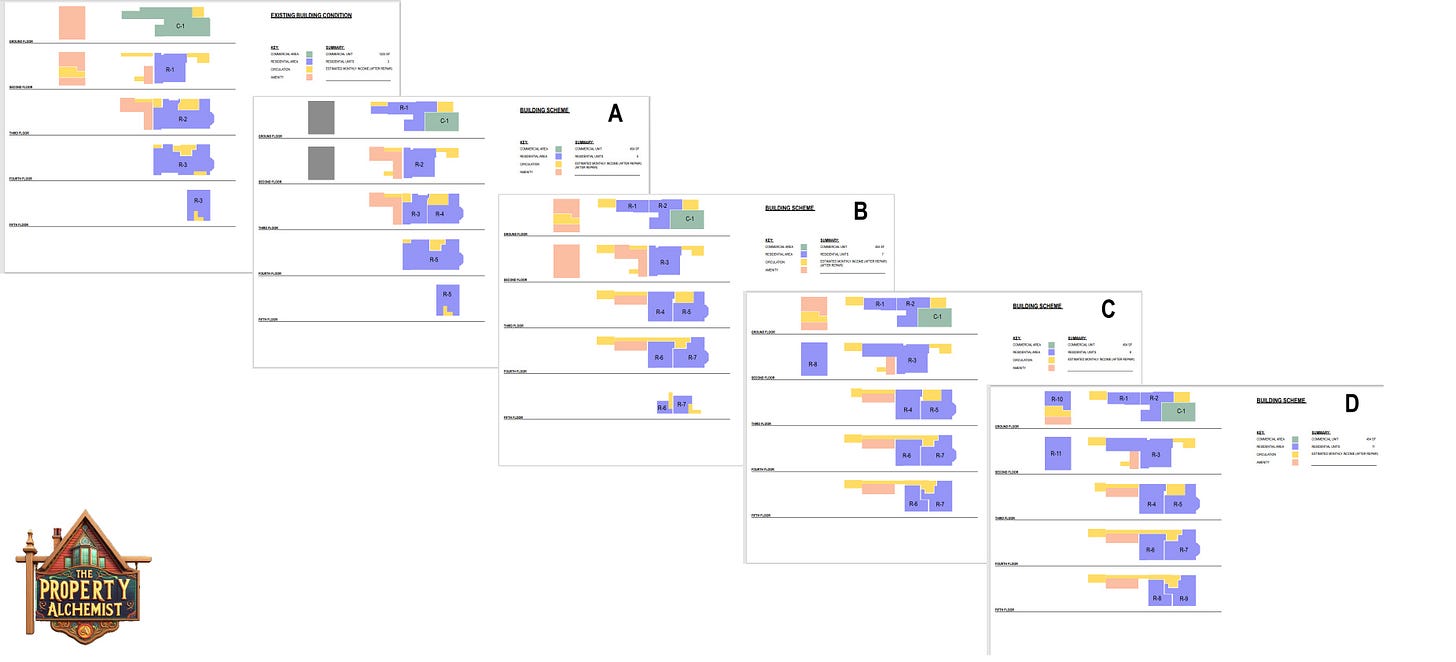The Turnaround: Picking A Redevelopment strategy
The property investment process has three basic steps: identify prospects, define the strategy, and execute. Each part of the process requires very different skills, picking the strategy is the most challenging part. Identifying prospects is all about spotting building defects, amenities, and the community. Execution is all about planning and scheduling. Defining the strategy is where the intellectual rubber meets the road. To define the strategy, one must be able to see multiple paths to the goal, model them financially, and analyze their viability.
In simpler models, the scope of the project and financial strategy is only bounded by the budget. Our approach seeks to evaluate the best and highest use for the property and maximize the yield on our investment. Our flexibility and access to liquidity enables us to find properties where value is locked behind high hurdles of capital outlays. For most investors downpayments of 20 to 30% are a seemingly insurmountable obstacle, thinking about the possibility of spending significantly more than that on improvements is simply impossible, for lack of liquidity. Being that we are in our third decade of this business, we are fortunate to have outgrown that problem. Simply put, our capital position allows us to compete in a unique property niche.
Having spent years looking at properties, I have found that there is a very specific type of building that matches our strategy. These buildings are usually owned by people who understand the value of investing in residential properties, are financially successful enough to buy something much bigger than a home but are often terrible business operators and always terrible landlords. These types of investors tend to operate their properties with unsustainable capital extraction. In other words, good buildings that have been tactically dilapidated by their owner to extract every penny of free cash flow.
In some cases, like our current investment in Troy, the previous owner created a situation where the building needs capital improvements of at least 50% of its cost. In practical terms, it means the building sold at $71 per sqft, in a market where the minimum new build cost is $300 per sqft.
Needless to say, it will not be cheap to renovate this building. But the $300 vs $71 is a red herring. This property is in the heart of a historic district where new builds face different requirements, is centrally located within a walkable town, and is surrounded by a vibrant neighborhood of eateries, shops, nightlife and culture. As the old real estate adage goes “Location, location, location.” Life is pretty good when you can walk to the market, the music venue, the coffee shop, and even the hardware store. While many investors tend to disregard the neighborhood level when it comes to investing, those of us who have lived in large cities know that a few blocks can make for huge property value swings and shifts from manicured yards to garbage strewn streets.
A second component of our strategy is product differentiation. Finding tenants with discretionary income willing to pay a premium requires producing a product worth paying a premium for. As Steve Job’s famously said “Build something wonderful.” In most urban environments, privacy, outdoor space, in-apartment or on-site amenities, public transport proximity, and parking availability are key drivers of premium. Well appointed, contemporary, and clean units also drive a premium, but that is true everywhere you go. For our current project, we picked a property with public transport proximity, easy access to off street parking, and ample outdoor space. We need to roll up our sleeves and redeveloped the property to create privacy, outdoor spaces, and well-appointed units with amenities that unlock those full premiums.
Our execution begins with creating a number of different proposals. Each proposal is designed to provide a project scope. We start with the existing layout and add proposals for large tranches of capital improvements, each approximately 70% of the acquisition cost. For each proposal, we get more units and rentable space, understanding that each proposal may be impacted by additional and increasingly stringent requirements. In other words, each chunk of capital can be modeled to measure its specific incremental yield, with an objective to optimize our investment across those potential investment tranches. In this case, our model shows that tranche A and B dramatically increased yield, while C and D tranches dramatically decrease incremental yield.
The more space you add on higher floors, the more of your budget gets eaten up by regulatory and compliance requirements, resulting in fewer rentable square feet. Seems like an obvious thing to say, but ground floor apartments don’t need a fire escape. Just one simple example of how building codes change the cost of construction, based on how high you are building off the ground. In the case of our project, it means we invest our first dollars in the lower floors and work our way up unlocking value until it is no longer profitable.
We culminated the first part of the strategy when we acquired our current project. We locked in all of the value of “location, location, location.” We culminate the second part of our strategy by setting a destination for our redevelopment journey that unlocks the value of the physical space and the community of residents that it creates, while optimizing yield and maximizing free cash flow. For our target customer, “It’s all about the vibes”.
With a strategy in hand, time to put together a plan. If our inspections, engineer’s reports, and architect’s assessment did their job, we now know what dragons we will face on our journey. So, as we construct our redevelopment plan, we heed the words of J.R.R. Tolkien - “It does not do to leave a live dragon out of your calculations, if you live near one.”
If you've found value in these insights and want to continue your journey of real estate wisdom, we invite you to subscribe to The Property Alchemist. Don't let your real estate dreams remain just dreams. Empower yourself with the knowledge and insights that can turn your investment visions into concrete reality. Subscribe to The Property Alchemist today and take the first step towards becoming a master of real estate alchemy. Your next successful project is just a subscription away!





